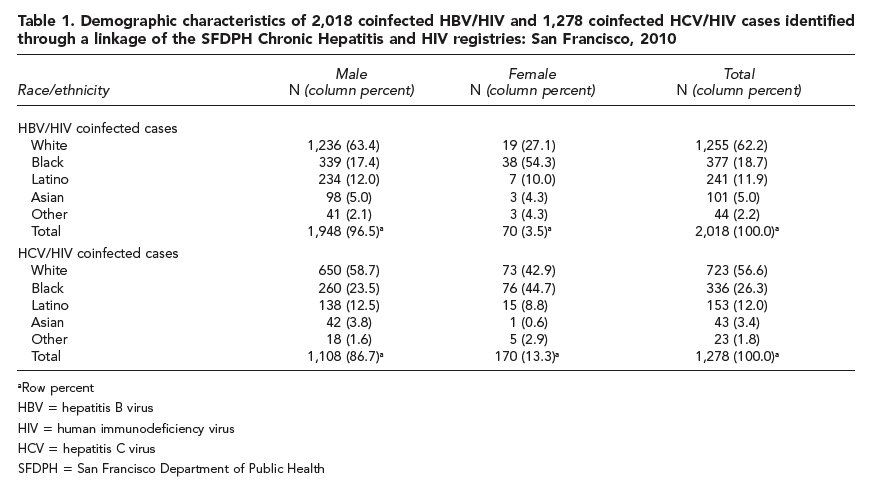| |
HCV in HIV+ MSM in SF:
"Epidemiology of the Viral Hepatitis-HIV Syndemic in San Francisco: A Collaborative Surveillance Approach"
|
| |
| |
Download the PDF here
"two sections within the San Francisco Department of Public Health (SFDPH)-the Communicable Disease Control and Prevention (CDCP) Section's (Chronic Viral Hepatitis Registry Team and the HIV Epidemiology Section's HIV/AIDS Surveillance Unit-collaborated to link their respective registries to describe the epidemiology of people coinfected with HBV or HCV and HIV in San Francisco."
".......notably, among HCV/HIV coinfected males, 35.6% were MSM but not IDUs. This high percentage of coinfected, non-injection drug-using MSM suggests that sexual activity may be a prominent mode of transmission for HCV infection among this HIV-infected male population. While sex is not considered an efficient mode of HCV transmission, several studies suggest that high-risk sexual behaviors, such as having multiple sexual partners and receptive anal fisting, increase the risk for infection...."
"Although the greatest burden of HCV/HIV coinfection was among white males, black people were disproportionately affected. Black males comprised 23.5% of the HCV/HIV coinfected males, and black females comprised 44.7% of the HCV/HIV coinfected females in this registry match. Overall, findings among this HCV/HIV coinfected population are consistent with those from several studies of HCV infection among HIV-infected populations in Western Europe and the U.S.4,8,9 Injection drug use was the most frequent risk factor for acquisition of HIV infection among the HCV/HIV coinfected population; however, notably, among HCV/HIV coinfected males, 35.6% were MSM but not IDUs. This high percentage of coinfected, non-injection drug-using MSM suggests that sexual activity may be a prominent mode of transmission for HCV infection among this HIV-infected male population. While sex is not considered an efficient mode of HCV transmission, several studies suggest that high-risk sexual behaviors, such as having multiple sexual partners and receptive anal fisting, increase the risk for infection. 17-22 Building upon the collaborative framework developed for this registry match, next steps to address this issue will involve further database integration with SFDPH's Sexually Transmitted Diseases Prevention and Control Services Program, which collects high-risk sexual practice data for cases within its registry. Database integration among all three sections would provide us the opportunity to examine the high-risk sexual practices of the HCV/HIV coinfected population to better understand the role of sexual practices in transmitting HCV and to develop and implement specific prevention recommendations to populations affected by this syndemic."

Public Health Reports / 2014 Supplement 1
Melissa A. Sanchez, PhD, MAa
Susan Scheer, PhD, MPHb
Sue Shallow, MPH, CACLSc
Sharon Pipkin, MPHb
Sandra Huang, MDc
aSan Francisco Department of Public Health, Communicable Disease Control and Prevention Section, Chronic Hepatitis Surveillance, San Francisco, CA
bSan Francisco Department of Public Health, HIV Epidemiology Section, San Francisco, CA
cSan Francisco Department of Public Health, Communicable Disease Control and Prevention Section, San Francisco, CA
ABSTRACT
Objectives. To describe the epidemiology of people coinfected with hepatitis B virus (HBV) or hepatitis C virus (HCV) and HIV in San Francisco, the San Francisco Department of Public Health's Communicable Disease Control and Prevention Section and the HIV Epidemiology Section collaborated to link their registries.
Methods. In San Francisco, hepatitis reporting is primarily through passive laboratory-based surveillance, and HIV/AIDS reporting is primarily through laboratory-initiated active surveillance. We conducted the registry linkage in 2010 using a sequential algorithm.
Results. The registry match included 31,997 HBV-infected people who were reported starting in 1984; 10,121 HCV-infected people who were reported starting in 2001; and 34,551 HIV/AIDS cases reported beginning in 1981. Of the HBV and HCV cases, 6.3% and 12.6% were coinfected with HIV, respectively. The majority of cases were white males; however, black people were disproportionately affected. For more than 90% of the HBV/HIV cases, male-to-male sexual contact (men who have sex with men [MSM]) was the risk factor for HIV infection. Injection drug use was the most frequent risk factor for HIV infection among the HCV/HIV cases; however, 35.6% of the HCV/HIV coinfected males were MSM but not injection drug users.
Conclusions. By linking the two registries, we found new ways to foster collaborative work and expand our programmatic flexibility. This analysis identified particular populations at risk for coinfection, which can be used by viral hepatitis and HIV screening, prevention, and treatment programs to integrate, enhance, target, and prioritize prevention services and clinical care within the community to maximize health outcomes.
|
|
| |
| |
|
|
|